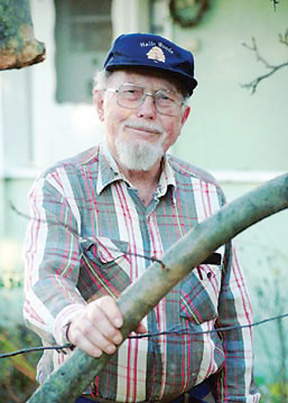Chesapeake Bay's Independent Newspaper ~ Since 1993
1629 Forest Drive, Annapolis, MD 21403 ~ 410-626-9888
Volume XVII, Issue 51 ~ December 17 - December 23, 2009
Home \\ Correspondence \\ from the Editor \\ Submit a Letter \\ Classifieds \\ Contact Us
Dining Guide \\ Home & Garden Guide \\ Archives \\ Distribution Locations \\ Advertising
![]()


 |
Where We Liveby Steve Carr |
Grandfather Oak
I followed 93-year-old Ned Hall’s footsteps to manhood
My passion for the environment started many years ago, with the Severn River Association. I was drawn to the nature walks, where a mischievous old-timer named Ned Hall led us through the woods and wetlands of the Severn River watershed, pointing to the trees and flowers like they were his children. I used to think to myself, That’s what I want to be when I grow up.
|
|
![]() Ned Hall, now 93, could charm the bark off a tree. Though not a teacher by trade, he has taught and nurtured a generation of Chesapeake Country environmentalists. Ned’s talent goes beyond knowing the names of all the local plants and animals; he knows the history of the lands where they’re found.
Ned Hall, now 93, could charm the bark off a tree. Though not a teacher by trade, he has taught and nurtured a generation of Chesapeake Country environmentalists. Ned’s talent goes beyond knowing the names of all the local plants and animals; he knows the history of the lands where they’re found.
The Halls were among the first Maryland colonists. In 1695, the Reverend Henry Hall left London and came to America to minister to the people of St. James Parish, then and now in Lothian. Ned’s grandfather, who had a model farm, started the local Farm Bureau, back in 1871. Ned and his dad took long walks together in the surrounding woods, and during these sojourns Ned developed his deep and abiding love of nature.
Ned’s dad became a land surveyor, and Ned followed in his footsteps. Ned inherited the family surveying business at his father’s death after World War II.
Anne Arundel County was a much different place back then.
I remember gathering one winter Saturday around College Creek for one of Ned’s Severn River Association walks. As we strolled through the woods where the Navy wanted to build a hotel, Ned described a baby-sized Annapolis that ended at the nearby Veterans Cemetery on Taylor Avenue. Germantown, West Annapolis, Parole and Eastport had yet to be annexed.
On an early spring walk in the upper reaches of Severn Run near Jabez Branch, which was under assault from the road builders, Ned painted a dramatically different vision of North County. Glen Burnie was a small railroad town, surrounded by farms. And BWI Airport was a peach farm dating back to the 1700s.
While visiting Ned’s Bell Branch forest on a spring day when the leaves were just busting out and subdivisions were popping up like troublesome weeds along Defense Highway, I heard about the many dairy farms in West County and how after both World Wars, Odenton was subdivided to create residences for the soldiers at Ft. Meade.
One winter morning as we walked around Holly Beach Farm, which was rumored to be for sale, Ned explained that St. Margaret’s had mostly been large horse farms dating back to colonial times, intermingled with smaller operations growing produce for the thriving truck farming industry for which Maryland was famous.
When there was a big dust-up about what would happen to the Brilliant Property along Bestgate Road, we walked the headwaters of Saltworks Creek and learned that after World War II, what was to be the Annapolis Mall was once covered with tobacco and corn fields. Horses and cows grazed in large numbers where fields of parked cars now stand. Parole Plaza, the Annapolis area’s first mall, was originally a famous colonial-era horse racing track.
When development was proposed for Sullivan’s Cove, we walked the fragile wetlands and Ned reminisced about the sleepy railroad stop of Boone, which was subdivided by the Hatton family for homes for all of the people commuting north and south on the train to work. This new bedroom community would soon be known as Severna Park.
It seemed like every place we visited on our monthly walks, Ned had surveyed. So I asked him if there was any place he hadn’t been.
Ned chuckled.
“World War II started the slow change of the county from rural to residential and commercial,” he said. “Soldiers returning from combat decided they no longer wanted to be farmers. So many farms were sold to make way for new residences. As one of only three surveyors in the whole county at that time, I ended up surveying nearly every farm.”
As the large tomato-canning operations in Odenton and Shady Side went out of business, large auction houses opened in nearby Upper Marlboro, helping make Southern Anne Arundel County the state’s tobacco capital. Before that, tobacco was packed in large hogsheads to be hauled by truck to the warehouses on Light Street in Baltimore.
After 30 years surveying the length and breadth of the county, Ned Hall retired in the early 1980s. At 93, his dedication to preserving the land is well recognized: He was honored in 2001 with the Jan Hollmann Environmental Education Award and this year named the first of the Chesapeake Bay String of Pearls. And that’s how he tells me he wants to be remembered: for “My love of the land.”
Every piece of land has its story, and Ned Hall helped me understand that those stories are windows into time. Through them, we see how we got to where we are today.
